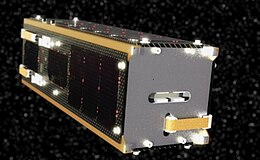 | |
| Mission type | Earth observation |
|---|---|
| Operator | CNTS / SSTL |
| COSPAR ID | 2002-054A[1] |
| SATCAT no. | 27559 |
| Mission duration | 7 years and 9 months |
| Spacecraft properties | |
| Manufacturer | SSTL |
| Launch mass | 88 kilograms (194 lb) |
| Start of mission | |
| Launch date | 28 November 2002, 06:07:00 UTC |
| Rocket | Kosmos-3M |
| Launch site | Plesetsk Cosmodrome |
| End of mission | |
| Deactivated | August 2010 |
| Orbital parameters | |
| Regime | Sun synchronous |
| Periapsis altitude | 700 kilometres (430 mi) |
| Apoapsis altitude | 700 kilometres (430 mi) |
| Inclination | 98 degrees |
| Period | 98.5 min |
ALSAT-1[2] is the first Algerian satellite and it is part of a group of satellites collectively known as the Disaster Monitoring Constellation (DMC).[3][4] The satellite was built by a group of engineers from Surrey Satellite Technology (SSTL) and Algerian Centre National des Techniques Spatiales (CNTS). It was the first DMC satellite to be launched of the five to seven that are planned. The DMC was the first satellite constellation designed for that objective. The launch took place on 28 November 2002 from the Plesetsk Cosmodrome in northern Russia on a Kosmos-3M launcher in -20 degree Celsius weather. It completed its mission after seven years and nine months in August 2010. The satellite was designed to operate for five years.[5]
AlSat-1 is built on the SSTL-100 platform. The onboard instrumentation consists of two banks with three Earth imaging cameras each that, in total, has a resolution of 32 meters in three spectral bands (NIR, red, and green). The imaging swath of the cameras is 600 km. The satellite was constructed in a fifteen-month time period by the British and Algerians, of which eleven Algerian engineers were trained by SSTL.[6] The satellite uses resistojets for propulsion, and butane as its propellant. The resistojets provide more than 20 m/s of delta velocity.[2]
- ^ "SPACEWARN Bulletin". NASA Space Science Data Coordinated Archive. 1 December 2002.
- ^ a b Cooksley, J; da Silva Curiel, A; Stephens, P; Boland, L; Jason, S; Sun, W; Sweeting, M (2003). ALSAT-1 First Year in Orbit. 17th AIAA / USU Conference on Small Satellites.
- ^ Gibbon, D; Boland, L; Bean, N; Hashida, Y; da Silva Curiel, A; Sweeting, M; Palmer, P (2004). Commissioning of a Small Satellite Constellation - Methods and Lessons Learned. 18th AIAA / USU Conference on Small Satellites.
- ^ Boland, L; da Silva Curiel, A; Sweeting, M; Stephens, P; Hodgson, D (2005). Disaster Monitoring Constellation (DMC) – Success Based on Small Satellite Technologies. 19th AIAA / USU Conference on Small Satellites.
- ^ Wolstenholme, Robin (26 August 2010). "Algeria's first satellite mission completed". Surrey Satellite Technology Limited. Archived from the original on 10 September 2017. Retrieved 24 March 2013.
- ^ Cite error: The named reference
sstlwas invoked but never defined (see the help page).